Menus
- Potato or mash ?
- BMW R 1250 GS 136 hp, 143 Nm at 6250 rpm, 249 kg all full, 17,600 euros (21,294 euros for the model tested with Comfort, Dynamic and Touring Pack).
- Honda Africa Twin Adventure Sports 100 hp, 105 Nm at 6250 rpm, 238 kg all full (250 kg in DCT / EERA), 16,899 euros (19,399 euros in DCT and EERA suspensions).
- Discovery
- In the saddle
- In the city
- On the highway
- Departmental
- All Terrain
- Braking
- Comfort
- Consumption
- The 100% bad faith comparison in video
- Conclusion
Potato or mash ?
BMW R 1250 GS 136 hp, 143 Nm at 6250 rpm, 249 kg all full, 17,600 euros (21,294 euros for the model tested with Comfort, Dynamic and Touring Pack).
Honda Africa Twin Adventure Sports 100 hp, 105 Nm at 6250 rpm, 238 kg all full (250 kg in DCT / EERA), 16,899 euros (19,399 euros in DCT and EERA suspensions).
The BMW GS big trail aura unfolded in the late 1990s; before she had her fans but never knew the popularity she enjoys today. Its great strength comes from the fact that it has continued to improve since the development of the R 80 GS, at the very end of the 70s. Its marketing began in 1981. Only a year later, another trail Twin-cylinder landed, also designed (partly) in Germany, the Honda XLV 750 R. But it disappeared in 1986, when the Transalp arrived. The Africa Twin appeared in 1988 to make way for the Varadero in 2003. The GS continued on its way. Hence a huge advantage over its competitors. Since the 2000s, all builders have hunted on its land; however, it remains unbeatable on the sales charts in many countries. Its engine took 450 cm3 in 40 years, it gained 86 hp but also around sixty kilos. From the original trail, ready to plunge into the hell of the Sahara, not much remains. She walks in a strange point of convergence between big trail, road and GT. Only its driving position and the travel of its suspensions make it a trail, if we refer to the old conception of the term. The new Honda Africa Twin Adventure Sports isn’t much better, but it still meets some codes, like the 21-inch front rim, 18-inch rear rim and narrow tires (90 wide front, 150 rear).
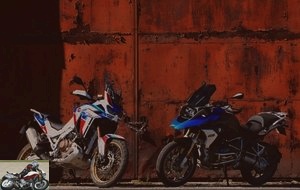 Motorcycle comparison BMW 1250 GS / Honda Africa Twin 1100
Motorcycle comparison BMW 1250 GS / Honda Africa Twin 1100
We spent almost three weeks riding the two behemoths; We even changed the tires to test the latest Dunlop Mutant and Meridian in addition, tested the Africa Twin Adventure Sports in DCT gearbox and EERA controlled suspensions, but also in classic gearbox and suspensions! See if we did it right. Verdict: David and I disagree, especially on the engine; he prefers mashed potatoes, I like potatoes. Before getting to the points of view, a technical overview.
Discovery
The BMW R 1250 GS is loaded with technology, both mechanically and electronically, as well as some chassis quirks. Its flat twin, known as Boxer, BMW’s distinctive mark, has four valves per cylinder and is cooled by air and water. Since 2018, its distribution, called ShiftCam, combines variable valve timing and differential valve lift to improve mid-range torque and power, similar to that of a Suz ‘GSX-R 1100 from mid-range. 1990s: 136 hp. Better, the engine has also gained in character. Another advantage of the Boxer engine, it lowers the center of gravity, when the vertical twin of the Honda places its masses a little higher..
The twin-cylinder of the Honda Africa Twin develops 102 hp, but above all a lower torque: 105 Nm at 6250 rpm against 143 Nm at the same speed for the BMW. The Honda, named Unicam for its single overhead camshaft, weighs less, without however the DCT (double clutch) box which puts a strain on the mechanical weight. On the other hand, it offers a peculiarity specific to Honda: the gears pass alone, the bike does not have a selector, but you can choose to take control and shift gears to the left stalk. On the mechanical side, each therefore has specific characteristics.
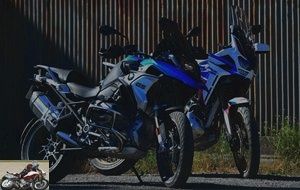 BMW 1250 GS and Honda Africa Twin 1100 side by side
BMW 1250 GS and Honda Africa Twin 1100 side by side
XXIst century and Euro5 standards oblige, their electronic equipment put on the top of the range. Traction control, anti-wheeling, deprogrammable ABS at the rear (but also at the front on the BMW, in off-road mode), different engine modes (road, off-road, rain, enduro…. Classic) but the Honda offers more customization possibilities, such as the choice of engine brake intensity, variable traction control according to seven levels…. and optional piloted suspensions (EERA) also configurable in multiple modes, including the basic "pilot alone", "duo", "with or without luggage", like the BMW ESA but with more choices. I take this opportunity to notice that if the classic settings are easily accessible on the Honda, it is not so simple when you want to enter the customization menu, we turned for a moment around the TFT screen and the controls for understand how it works. Fortunately the screen is tactile because it is hell via the commodos. The dealer will be there a great help.
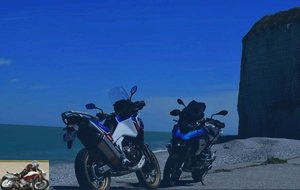 Enemy trails
Enemy trails
The cycle parts also differ. The BMW contains its engine in a trellis frame made of steel tubes, with special suspensions: Telelever in front, which distinguishes the guiding of the front wheel from its damping, carried out by a triangulated arm and a shock absorber. It filters imperfections better and ensures better ABS operation, but gives less front end feel than a conventional fork, especially in sporty driving. The Paralever, at the rear, is a sort of big single-sided arm that incorporates the shaft and cardan transmission. It attenuates the effects of "lifting" during acceleration and also participates in the effect of suspension, allied of course to a shock absorber.
The Africa Twin Adventure Sports has such a classic frame, with two steel side elements and a single split cradle, with classic suspensions, from Showa and the piloted suspension option mentioned above. In terms of dimensions, the Honda has a slightly longer wheelbase (1,575 mm versus 1,514 mm), with a higher trail as well (113 mm versus 100 mm). And its masses are higher placed, especially with the large 24.8-liter full tank, characteristic element of the Adventure Sports version. We will see that these important technical differences naturally explain the behavior of each of these travelers, ready to make some deviations along the way..
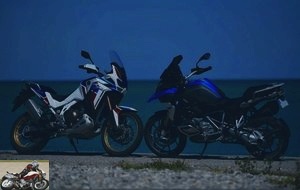 BMW 1250 GS / Honda Africa Twin 1100 off-road
BMW 1250 GS / Honda Africa Twin 1100 off-road
In the saddle
The saddle height, size and perceived weight are essential criteria for these motorcycles. You don’t even have to ride to perceive them, a simple seat in the showroom of a dealership already provides some answers. Identical in saddle height (850 mm) in the standard version (low saddles exist, at 800 mm for the GS and 820 mm for the Africa Twin Adventure Sports), the BM ’is nevertheless more easily straddled. Africa’s sharper rear explains it. Once in place, the single foot for the small rider also finds a more obvious point of support on the R 1250 GS. My six-foot-eight is more comfortable there, even with the two bikes in the low saddle. GS Advantage.
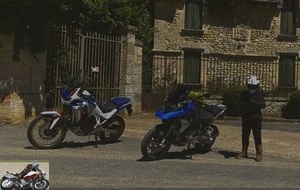 Ready for the test !
Ready for the test !
Our test GS, almost full option (Comfort Pack, Dynamic and Touring, which bring its price to 21,294 euros), starts with the key in the pocket. The Honda remains "old-fashioned". Small flaw of the latter, a slightly short crutch which sometimes forces you to find the right place to park. The two bubbles are adjusted manually, via a dial on the BMW which allows the height to be changed while driving. On the Honda, you need both hands…. Ditto for the dashboard, that of the German is clearer, simpler, its menus scroll more clearly than on the Honda, where we do not understand at the beginning what means "HRS RTE" (for off-road ) or "CYCLOT" (for cycle touring) but you get used to it. Two user modes on the Africa customize settings. Most of the time I chose traction control at 1, the most responsive engine mode (max power) and engine brake (EB) on position 2. As for the BMW, I prefer the sportier mode called ‘ Dynamic ‘but David chose Road mode, with a more progressive throttle response. Not easy to take control of bikes in 2020…. But nice to be able to adapt the bikes to our preferences. Every medal has two sides.
Once started, the weight is less noticeable on the R 1250 GS, again because it is placed low. Curiously, it is also more agile at low speed, with its tires, however, wider (120 in front and 170 behind). The huge advantage of the Honda, at start-up as well as at low speeds, comes from its DCT gearbox, when the option was chosen. No jerks when starting, a real peace of mind at the traffic lights and especially in town. It is necessary to prefer the S1 mode to have a correct downshifting, which does not make the motorcycle “cough” below 2000 rpm.
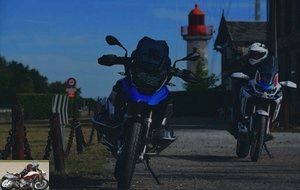 BMW 1250 GS and Honda Africa Twin 1100 on a daily basis
BMW 1250 GS and Honda Africa Twin 1100 on a daily basis
In the city
Both squeeze in well, despite their wide handlebars. The BMW’s agility is impressive, but the U-turns are easier with the Honda when you keep a little speed. On the other hand, stationary travel quickly becomes painful with the Africa Twin, especially when you’re not tall. The GS’s natural balance also makes maneuvering easier. On the braking side, the two are equal, powerful and progressive. The Honda tilts more forward, with its typical trail fork movement, without inconvenience.
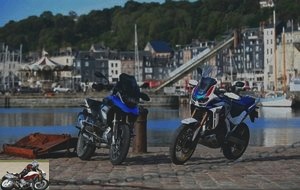 BMW 1250 GS and Honda Africa Twin 1100 in town
BMW 1250 GS and Honda Africa Twin 1100 in town
On the highway
This is a place where you often come across GS, a clue that proves its road side. The position is cool, the saddle and the suspensions comfortable, it snaps at 4,000 rev / min at 140 meter, speed regulator engaged, well hidden behind the bubble…. In duet or loaded, no difference, the covers in sixth are frank and vigorous.
On the Africa Twin, the motorway watch goes less well, because of a much less comfortable saddle (solo and duo but also in part because it was the lower saddle option harder than normal) and ‘a high bubble with sometimes painful reflections, especially the sun in front. It even distorts the vision a little. It stalls at 4,600 rpm at 140 counter, also equipped with the regulator.
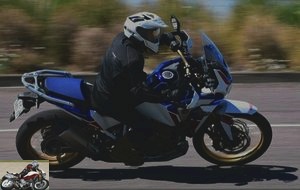 The Africa Twin 1100 in a corner
The Africa Twin 1100 in a corner
Departmental
We traveled through Normandy from the coast to the Alpes Mancelles, with a return via the Perche. We lived like this with these motorcycles on a daily basis, for more than two weeks. And despite the Africa Twin’s faults mentioned above, this is the one I liked the most. First for its engine, less powerful, but brawler, boxer at mid-range, with a little dry sound. As if Noirmoutier potatoes, these small, badly rounded, firm potatoes were toppled in each cylinder. It gives him character, personality. David prefers the smoothie roundness of the BM ’, supple, available in all gears even at low revs, nimble, powerful above 5,000 rpm, even furious, but smoother. It all comes out a bit of a potato masher, but like a turbo. The contrast is there, with the GS we are faster more easily than the Africa Twin to the detriment of the nervousness felt.
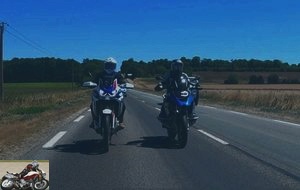 We have traveled more than 1,000 kms on their handlebars
We have traveled more than 1,000 kms on their handlebars
Between 4,000 and 7,000 rpm, I like the potatoes of the Africa Twin and the movement can last a long time with the 24.8-liter tank, almost 400 miles if you don’t shake its rind too much. The BMW does a little less with its 19 liters but the 350 terminals are easily in its strings.
And then there is the chassis. From a neutral, objective point of view, the manoeuvrable, agile and stable BMW has no faults in this point of view. You never feel its 249 kg. Its suspensions filter everything, even too much when you tease the front end a little brutally, you lack feeling. But this zero defect tends to translate into a lack of personality (which David doesn’t agree with), which goes well with his engine at mid-range. Always available, flexible, easy ….
The Africa Twin takes more life. It requires a little grip to be taken, which does not pose a problem of confidence since its stability is imperial, even more with the Dunlop Trailmax Meridian (220 euros the train) than with the original Metzeler Karoo Street, less rigorous on the road but offering better handling. The Showa suspensions, with or without the EERA option, provide better feedback than the muscular BMW’s. The fork, even hard set, always sinks in a bit quickly when braking, but this phenomenon is well compensated for by effective hydraulic expansion, which prevents the tubes from going up too quickly and destabilizing the bike. The high weight of the Africa, on the other hand, is felt in the sequences or when rocking the bike frankly. When driving smoothly but fast, it still gives more sensations but goes slower than the faster BMW without effort. The BMW, efficient, filters and is forgotten. She follows without flinching. Now, I ride motorcycles for the exchange I can establish with her, I don’t like her to fade away. A matter of taste.
All Terrain
Let’s get on well, we haven’t done any enduro special or muddy roads, just rocky or wide earthy ones. The Africa Twin has a strong off-road attitude, it dominates the front, rarely loses grip thanks to its long wheelbase and its driving position is natural. The BMW is a little less stable and its Dunlop Mutant tires, which we fitted, are more road than TT, their grip on the road is not great. David however preferred the BMW which sits more easily and is less abrupt, giving more confidence. The original Metzeler Karoo are more efficient here. Honda electronics also tune better for TT than BMW, especially traction control, in Gravel mode.
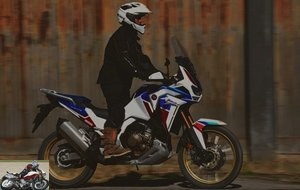 The Africa Twin 1100’s playground
The Africa Twin 1100’s playground
The only downside for the Honda is that the DCT is less fun in TT, where we like to use the clutch and high revs. On the other hand, it makes it possible to never stall.
Braking
The two bikes are equal in stopping power, which is excellent, but the reaction of the BMW is even more gradual, it dives less from the front. This is not a fault with the Africa Twin, but reinforces its trail personality. Advantage of the GS, the ABS can also be disconnected from the front.
Comfort
Here is the black point of the Honda, its uncomfortable saddle after two hours of road, both for the pilot and the passage. The suspensions are fine, but the low saddle is unworthy of a motorcycle over 17,000 euros; it improves with the normal saddle (so even if you are small and want an Africa Twin, prefer the normal saddle, otherwise you will really suffer in terms of comfort). The BMW surpasses it by far in this area, whether for the pilot or the passenger. And the passenger is a little too high on the Africa and takes disturbances that the bubble in the high position does not deflect for him (or her).
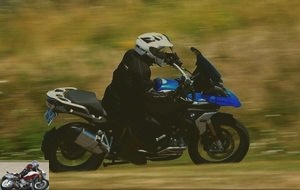 The handling of the BMW 1250 GS is impressive
The handling of the BMW 1250 GS is impressive
Consumption
By driving together on secondary roads and a few expressways then towns, we observed a similar consumption for the two motorcycles: around 5 l / 100 km. Having ridden more with the Honda, I was able to cut this consumption several times, with a peak of 5.8 l / 100 km. What remains reasonable for motorcycles of this weight.
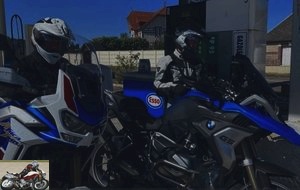 Autonomy between 350 and 400 kms
Autonomy between 350 and 400 kms
The 100% bad faith comparison in video
Conclusion
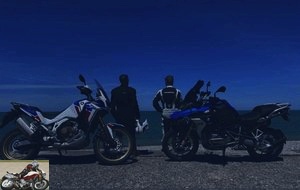 We stop bickering and look at the sea !
We stop bickering and look at the sea !
So there you have it, at the time of the verdict, David wasted no time in proclaiming his choice for the BMW. Easier, less painful for small sizes, more punchy at high speeds, more comfortable too, I fully understand that. For my part, I prefer the sporty trail side of the Africa Twin Adventure Sports, with its small engine character, its more assertive (and prettier) face, its thin tires, its more fun side. The price is not for nothing either: 19,399 euros for a fully equipped Honda (DCT, EERA piloted suspensions….), With advanced electronics, cool tips such as additional curved lighting, which comes on with a little angle; the BMW asks for more than 21,000 euros with comparable equipment, without however the DCT. Conversely, the entry price of the Africa Twin, standard and not Adventure Sports (which starts at 16,899 euros without DCT and EERA), does not exceed 13,999 euros at this time (with a 5-year warranty). The BMW R 1250 GS has a base price of 17,600 euros but is less well equipped and requires options to be really on top. It counts.
Highlights BMW 1250 GS
- Motor
- Versatility
- Comfort
Weak points BMW 1250 GS
- Price
- Options
Highlights Honda Africa Twin
- Motor
- Electronic
- Cycle part
- 5 year warranty
Weak points Honda Africa Twin
- Comfort
- Weight
- Accessibility
The technical sheet of the BMW 1250 GS
The technical sheet of the Honda Africa Twin 1100
Test conditions
- 15 days of daily testing
- Itinerary: 1000 kms from Paris to Normandy
Related articles
-
Honda Africa Twin CRF1100L Adventure Sports motorcycle test
100 hp, 105 Nm at 6,250 rpm, 238 kg all full (250 kg in DCT / EERA), 16,899 euros (19,399 euros in DCT and EERA suspensions). The spirit is there It…
-
Some subtle changes for the 2018 version of the trail In-line twin, 998 cm3, 95 hp at 7,500 rpm, 98 Nm at 6,000 rpm, from 237 kilos, from 13,549 € The…
-
Honda Africa Twin Adventure Sports test
Honda returns to the adventurous spirit of the original Africa Twins In-line twin, 998 cm3, 95 hp at 7,500 rpm, 98 Nm at 6,000 rpm, from 243 kilos, from…
-
Comparo Honda CRF1100L Africa Twin and Adventure Sports
Two Africa Twin 1100 for the price of one! or the opposite ? Angry backpackers After a masterful comeback in 2016, the Honda Africa Twin CRF1000L…
-
Comparo Honda X-ADV / Africa Twin
Vendetta Sino-Corsica With two flagship models, Honda returns to adventure and versatility. Both the return of the legendary CRF1000L Africa Twin and the…
-
Honda Africa Twin CRF1000L test
Honda CRF1000L Africa Twin ABS and DCT version Legends never die. Like the phoenix, the Africa Twin is reborn from the sand of its past exploits in a…
-
Honda Africa Twin test in the mud
Three levels of traction control, disconnectable ABS, DCT: useful, or not ? A life-size test at the Honda Adventure Center in Wales A real commercial…
-
Honda CB650R and CBR650R motorcycle comparison test
Beneficial Redesign for the roadster and the streamlined roadster become sporty ? Engine and cycle parts optimized for the two 2019 Honda vintages Based…
-
Face to face with the 2016 DCT and ABS trail versus the 2001 vintage Saga Africa As a reminder, the origin of the Africa Twin is a prototype, the NXR 750…
-
Cargo Flat twin, 1254 cm3, 136 hp, 143 Nm, 243 kg all full facts, 15,350 euros. Old tradition as the RS model at BMW, until the previous R 1200 RS. The…
Well I found it atrocious at the time, but I’m not so categorical anymore, there is a playful and fun side to the machine that makes you want to test it. Not to buy one, but just to go have a little fun with it. I think that’s the main objective of the thing
Incidentally, almost 50hp for 130 kg, it must be a real toy (regardless of the aesthetics … er … special).
Electric scooters may indeed be more expensive to buy, but on closer inspection, we make real savings in the long term: savings on fuel (electric of course), on insurance, on fuel. ‘maintenance … A cost comparator on their website shows the difference between two equivalent electric and thermal scooter models: [www.govecs.fr]
A 5 L tank ??? what a shame.
If we fill it in the reserve we will put a maximum of 4 L which is lower than the mandatory minimum delivery in a service station. (5L)
Well done Mr. Suzuki.
On the other hand, having put a clutch back on a CVT transmission that is also strong. Rather, it is an editor’s error.
Hand on the brake lever (and no clutch of course). Corrected. Please read carefully 🙂
For the tank, the capacity is standard for a small 125, it provides a range of 200 km, and I refueled several times at 4 liters without ever being bothered by the gas station attendant 🙂
Review every how many KMS. ?…
Cost of an overhaul ?…
consumables ?…
A + … VVV … zouc.
I find these two motorcycles difficult to compare as the BMW has a happy road orientation while Honda insists on the Off Road side of his bike.
 ).
).
And despite all their qualities to both, it is clear that certain limits are reached in the ease of use with their saddle height, Himalayan for many, and moreover completely unnecessary in 99.99% cases (I know how to stay measured !
For good reason, their suspension deflections which impose large ground clearance, suspensions which will hardly ever be used since they are calibrated for the most severe cases, that is to say reception of jump in off road without the crankcase hitting the ground !
170mm of travel is more than enough to provide comfort on bad roads and safety on easy paths for this type of large displacement.
Do the math; Africa Twin, standard 850 / 870mm saddle; suspension deb: 230mm with 170mm this would give 790 / 810mm saddle top without affecting the handlebar / saddle / footrest triangle, we could even improve it by increasing the saddle / footrest gap.
Same demonstration in less caricature for the BMW where we can easily gain 20mm of seat height.
But here are the great spaces and the fantasized adventure that sells, even if a Bob Morane of less than 1.80m can take one at every stop in town; we are living in a wonderful time !
I totally agree with the comment above, I was looking forward to the new model to replace my 2012 Burgman 400 … Finally, I will make it last longer, because this 2017 model does not please me. All the practical aspects that made its reputation and its success have disappeared with this new version. When we change, we want something better, this is not the case here and it is not a few leds here and there that are fronting something. No more locking glove box, no more lights in the trunk in the dark garage, less comfort in the saddle, a trunk that loses 20 liters in the process and a prohibitive price will eventually make me believe that Suzuki has completely missed its target. Moreover, since its marketing, sales have never taken off! When will a REAL Burgman 400 return with more than 30 horsepower under the boot? And in addition today, no model offers so many features: the too sporty Yamaha X-Max 400 as well as the pretty but not very functional Kymco X-Citing 400 and above all in the very disconcerting driving position, the BMW C400 GT which does not ‘Has de Gt that the name its safe is so much a joke and is badly done … not to mention its prohibitive price! Perhaps the future SYM MaxSym 400 which was presented in 2019 … but will it be marketed in France?
Burgman CATASTROPHIC SUSPENSIONS and SHOCK ABSORBERS ?!!!!
I compared a lot of scooters before deciding to buy the new Burgman Executive 650. It seemed more comfortable, to have better torque, etc….
After 2 years, I am obliged to note, with other owners of the same scooter, that the SUSPENSIONS and SHOCK ABSORBERS are CATASTROPHIC? !!! : They break your back and back, and make driving on cobbled or degraded streets very dangerous. The motorcycle no longer sticks to the road, so the wheels bounce off the road. So much so that when braking, the front suspension hits and locks.
Unacceptable on a machine of this price supposed to be comfortable. SUZUKI MUST CORRECT THE TIRE.
It even makes me regret my Tmax for its suspension 10 times better.
I just came out of a physiotherapy session trying to repair my lumbar damaged by the motorcycle (in particular). A good hearer ….
Ditto on my Honda 600 from 2015, only solution, fit EMC shock absorbers (650 €) after it is comfort and road holding guaranteed
We wondered for a moment, if a TMax could swim in a port as well as a FJR, but we did not dare
99.99% it was humor, which is to say that it is a very small minority !
I rode 11 years in Flat including 5 in GS, the 1200 DOHC, and I loved it !
I tried the Off Road (obligatory) it is the ordeal as soon as it becomes technical (mud, ruts, etc.) I do not even count the budget for repairing cylinder head guards and other parts with each fall, and finding yourself stuck under 250 kg of metal it’s not serious !
It’s really only on dry forest roads that it does, but precisely above that it goes with less suspension travel, you just need to have the right tires and the right pressures..
With the Africa it goes even easier (I tried), but I no longer agree with these motorcycles with TT orientations marked ditto Yam Tenere, I leave the paths to walkers, mountain bikers, dogs etc.) so I don’t need a wader !
My area of predilection, the small roads even those with a macadam fifrelin and the floral decoration in the middle, that I love, and the bingo ! I took the VFR 800 X, it does the job when there is no more tar, a sport when the coating is good, in short a real Swiss Army knife, very good suspensions with sufficient travel, and suddenly you get found with more acceptable saddle heights, a subject well addressed in the essay "Den". (810-830 on the Crossrunner, for my meter seventy-five 830 is great)
I took the VFR 800 X, it does the job when there is no more tar, a sport when the coating is good, in short a real Swiss Army knife, very good suspensions with sufficient travel, and suddenly you get found with more acceptable saddle heights, a subject well addressed in the essay "Den". (810-830 on the Crossrunner, for my meter seventy-five 830 is great)
I would be curious to see how the sales would be split between a BMW R 1250 "XR" vs GS.
Above it no need 200mm of travel !
[attachment 35348 P1120640-Copie.JPG]